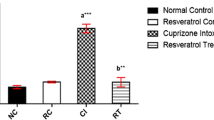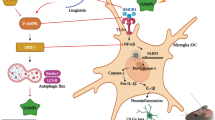Abstract
Over the past few decades several attempts have been made to introduce a potential and promising therapy for Multiple sclerosis (MS). Calorie restriction (CR) is a dietary manipulation to reduce calorie intake which has been shown to improve neuroprotection and attenuate neurodegenerative disorders. Here, we evaluated the effect of 33% CR regimen for 4 weeks on the remyelination capacity of Cuprizone (CPZ) induced demyelination in a mouse model of MS. Results showed that CR induced a significant increase in motor coordination and balance performance in CPZ mice. Also, luxol fast blue (LFB) staining showed that CR regimen significantly improved the remyelination in the corpus callosum of CPZ + CR mice compared to the CPZ group. In addition, CR regimen significantly increased the transcript expression levels of BDNF, Sox2, and Sirt1 in the corpus callosum of CPZ mice, while decreasing the p53 levels. Moreover, CR regimen significantly decreased the apoptosis rate. Furthermore, astrogliosis (GFAP + astrocytes) and microgliosis (Iba-1 + microglia) were significantly decreased by CR regimen while oligodendrogenesis (Olig2+) and Sirt1 + cell expression were significantly increased in the corpus callosum of CPZ + CR mice compared to the CPZ group. In conclusion, CR regimen can promote remyelination potential in a CPZ-demyelinating mouse model of MS by increasing oligodendrocyte generation while decreasing their apoptosis.








Similar content being viewed by others
Change history
23 September 2023
A Correction to this paper has been published: https://doi.org/10.1007/s11011-023-01297-1
References
Barati S, Kashani IR, Tahmasebi F, Mehrabi S, Joghataei MT (2019) Effect of mesenchymal stem cells on glial cells population in cuprizone induced demyelination model. Neuropeptides 75:75–84
Berghoff SA, Gerndt N, Winchenbach J, Stumpf SK, Hosang L, Odoardi F et al (2017) Dietary cholesterol promotes repair of demyelinated lesions in the adult brain. Nat Commun 8(1):1–15
Blakemore W, Franklin R (2008) Remyelination in experimental models of toxin-induced demyelination. Advances in multiple Sclerosis and Experimental Demyelinating Diseases. Springer, Berlin, pp 193–212
Bok E, Jo M, Lee S, Lee B-R, Kim J, Kim H-J (2019) Dietary Restriction and Neuroinflammation: A Potential Mechanistic Link. Int J Mol Sci 20(3):1–20
Chiba T, Ezaki O (2010) Dietary restriction suppresses inflammation and delays the onset of stroke in stroke-prone spontaneously hypertensive rats. Biochem Bioph Res Co 399(1):98–103
Choi IY, Piccio L, Childress P, Bollman B, Ghosh A, Brandhorst S et al (2016) A diet mimicking fasting promotes regeneration and reduces autoimmunity and multiple sclerosis symptoms. Cell Rep 15(10):2136–2146
Choi IY, Lee C, Longo VD (2017) Nutrition and fasting mimicking diets in the prevention and treatment of autoimmune diseases and immunosenescence. Mol Cel Endocrinol 455:4–12
Cohen DE, Supinski AM, Bonkowski MS, Donmez G, Guarente LP (2009) Neuronal SIRT1 regulates endocrine and behavioral responses to calorie restriction. Genes Dev 23(24):2812–2817
Colman RJ, Anderson RM, Johnson SC, Kastman EK, Kosmatka KJ, Beasley TM et al (2009) Caloric restriction delays disease onset and mortality in rhesus monkeys. Science 325(5937):201–204
Copray S, Huynh JL, Sher F, Casaccia-Bonnefil P, Boddeke E (2009) Epigenetic mechanisms facilitating oligodendrocyte development, maturation, and aging. Glia 57(15):1579–1587
Corpas R, Griñán-Ferré C, d Rodríguez-Farré E, Pallàs M, Sanfeliu C (2019) Resveratrol Induces Brain Resilience Against Alzheimer Neurodegeneration Through Proteostasis Enhancement. Mol Neurobiol 56(3):1502–1516
Csiszar A, Labinskyy N, Jimenez R, Pinto JT, Ballabh P, Losonczy G et al (2009) Anti-oxidative and anti-inflammatory vasoprotective effects of caloric restriction in aging: role of circulating factors and SIRT1. Mech Ageing Dev 130(8):518–527
Cunha-Santos J, Duarte-Neves J, Carmona V, Guarente L, De Almeida LP, Cavadas C (2016) Caloric restriction blocks neuropathology and motor deficits in Machado–Joseph disease mouse models through SIRT1 pathway. Nat commun 7:11445
Deng X, Cheng J, Zhang Y, Li N, Chen L (2010) Effects of caloric restriction on SIRT1 expression and apoptosis of islet beta cells in type 2 diabetic rats. Acta Diabetol 47(1):177–185
Denic A, Johnson AJ, Bieber AJ, Warrington AE, Rodriguez M, Pirko I (2011) The relevance of animal models in multiple sclerosis research. Pathophysiology 18(1):21–29
Esquifino AI, Cano P, Jimenez-Ortega V, Fernández-Mateos MP, Cardinali DP (2007) Immune response after experimental allergic encephalomyelitis in rats subjected to calorie restriction. J Neuroinflamm 4(1):6
Fontana L, Partridge L, Longo VD (2010) Extending healthy life span—from yeast to humans. Science 328(5976):321–326
Gabandé-Rodríguez E, Gómez de las Heras MM, Mittelbrunn M (2020) Control of inflammation by Calorie restriction mimetics: on the crossroad of autophagy and mitochondria. Cells 9(1):1–22
Ghaiad HR, Nooh MM, El-Sawalhi MM, Shaheen AA (2017) Resveratrol promotes remyelination in cuprizone model of multiple sclerosis: biochemical and histological study. Mol Neurobiol 54(5):3219–3229
Gharibi T, Ahmadi M, Seyfizadeh N, Jadidi-Niaragh F, Yousefi M (2015) Immunomodulatory characteristics of mesenchymal stem cells and their role in the treatment of multiple sclerosis. Cell Immunol 293(2):113–121
Ghasemi N, Razavi S, Nikzad E (2017) Multiple sclerosis: pathogenesis, symptoms, diagnoses and cell-based therapy. Cell J 19(1):1–10
Gold SM, Voskuhl RR (2009) Estrogen treatment in multiple sclerosis. J Neurol Sci 286(1–2):99–103
Gräff J, Kahn M, Samiei A, Gao J, Ota KT, Rei D et al (2013) A dietary regimen of caloric restriction or pharmacological activation of SIRT1 to delay the onset of neurodegeneration. J Neurosci 33(21):8951–8960
Haji Molahoseini M, Yeganeh F (2016) The Impact of Ramadan Fasting on SIRT1 mRNA Expression in Peripheral Blood Mononuclear Cells. Res Mol Med 4(4):51–55
Halabchi F, Alizadeh Z, Sahraian MA, Abolhasani M (2017) Exercise prescription for patients with multiple sclerosis; potential benefits and practical recommendations. BMC Neurol 17(1):185
Halagappa VKM, Guo Z, Pearson M, Matsuoka Y, Cutler RG, LaFerla FM et al (2007) Intermittent fasting and caloric restriction ameliorate age-related behavioral deficits in the triple-transgenic mouse model of Alzheimer’s disease. Neurobiol Dis 26(1):212–220
Hamadeh MJ, Rodriguez MC, Kaczor JJ, Tarnopolsky MA (2005) Caloric restriction transiently improves motor performance but hastens clinical onset of disease in the Cu/Zn-superoxide dismutase mutant G93A mouse. Muscle Nerve 31(2):214–220
Herskovits AZ, Guarente L (2014) SIRT1 in neurodevelopment and brain senescence. Neuron 81(3):471–483
Hu Y, Liu J, Wang J, Liu Q (2011) The controversial links among calorie restriction, SIRT1, and resveratrol. Free Radic Biol Med 51(2):250–256
Jadidi-Niaragh F, Mirshafiey A (2011) Therapeutic approach to multiple sclerosis by novel oral drugs. Recent Pat Inflamm Allergy Drug Discov 5(1):66–80
Jadiya P, Chatterjee M, Sammi SR, Kaur S, Palit G, Nazir A (2011) Sir-2.1 modulates ‘calorie-restriction-mediated’prevention of neurodegeneration in Caenorhabditis elegans: implications for Parkinson’s disease. Biochem Bioph Res Co 413(2):306–310
Jensen T, Kiersgaard M, Sørensen DB, Mikkelsen L (2013) Fasting of mice: a review. Lab Anim 47(4):225–240
Kafami L, Raza M, Razavi A, Mirshafiey A, Movahedian M, Khorramizadeh MR (2010) Intermittent feeding attenuates clinical course of experimental autoimmune encephalomyelitis in C57BL/6 mice. Avicenna J Med Biotechnol 2(1):47
Kashani IR, Chavoshi H, Pasbakhsh P, Hassani M, Omidi A, Mahmoudi R et al (2017) Protective effects of erythropoietin against cuprizone-induced oxidative stress and demyelination in the mouse corpus callosum. Iran J Basic Med Sci 20(8):886
Lee JT, Gu W (2013) SIRT1: regulator of p53 deacetylation. Genes Cancer 4(3–4):112–117
Lončarević-Vasiljković N, Pešić V, Tanić N, Milanović D, Popić J, Kanazir S et al (2009) Changes in markers of neuronal and glial plasticity after cortical injury induced by food restriction. Exp Neurol 220(1):198–206
Loncarevic-Vasiljkovic N, Pesic V, Todorovic S, Popic J, Smiljanic K, Milanovic D et al (2012) Caloric restriction suppresses microglial activation and prevents neuroapoptosis following cortical injury in rats. PLoS One 7(5):e37215
Madadi S, Pasbakhsh P, Tahmasebi F, Mortezaee K, Khanehzad M, Boroujeni FB et al (2019) Astrocyte ablation induced by La-aminoadipate (L-AAA) potentiates remyelination in a cuprizone demyelinating mouse model. Metab Brain Dis 34(2):593–603
Mojaverrostami S, Bojnordi MN, Ghasemi-Kasman M, Ebrahimzadeh MA, Hamidabadi HG (2018) A Review of Herbal Therapy in Multiple Sclerosis. Adv Pharm Bull 8(4):575
Nimmagadda VK, Bever CT, Vattikunta NR, Talat S, Ahmad V, Nagalla NK et al (2013) Overexpression of SIRT1 protein in neurons protects against experimental autoimmune encephalomyelitis through activation of multiple SIRT1 targets. J Immunol 190(9):4595–4607
Nimmagadda VK, Makar TK, Chandrasekaran K, Sagi AR, Ray J, Russell JW et al (2017) SIRT1 and NAD + precursors: Therapeutic targets in multiple sclerosis a review. J Neuroimmunol 304:29–34
Omodei D, Fontana L (2011) Calorie restriction and prevention of age-associated chronic disease. FEBS Lett 585(11):1537–1542
Piccio L, Stark JL, Cross AH (2008) Chronic calorie restriction attenuates experimental autoimmune encephalomyelitis. J leukoc Biol 84(4):940–948
Pourabdolhossein F, Hamidabadi HG, Bojnordi MN, Mojaverrostami S (2017) Stem cell therapy: A promising therapeutic approach for multiple sclerosis. In: Perspectives in Treatment and Pathogenesis [Internet]. Codon Publications, Multiple Sclerosis
Radler ME, Hale MW, Kent S (2014) Calorie restriction attenuates lipopolysaccharide (LPS)-induced microglial activation in discrete regions of the hypothalamus and the subfornical organ. Brain Behav Immun 38:13–24
Ran M, Li Z, Yang L, Tong L, Zhang L, Dong H (2015) Calorie restriction attenuates cerebral ischemic injury via increasing SIRT1 synthesis in the rat. Brain Res 1610:61–68
Richardson A, Austad SN, Ikeno Y, Unnikrishnan A, McCarter RJ (2016) Significant life extension by ten percent dietary restriction. Ann NY Acad Sci 1363(1):11–17
Tahmasebi F, Pasbakhsh P, Mortezaee K, Madadi S, Barati S, Kashani IR (2019) Effect of the CSF1R inhibitor PLX3397 on remyelination of corpus callosum in a cuprizone-induced demyelination mouse model. J Cell Biochem 120(6):10576–10586
Tegla CA, Azimzadeh P, Andrian-Albescu M, Martin A, Cudrici CD, Trippe R III et al (2014) SIRT1 is decreased during relapses in patients with multiple sclerosis. Exp Mol Pathol 96(2):139–148
Villoslada P, Steinman L (2020) New targets and therapeutics for neuroprotection, remyelination and repair in multiple sclerosis. Expert Opin Inv Drug 29:1–17
Wang J, Ho L, Qin W, Rocher AB, Seror I, Humala N et al (2005) Caloric restriction attenuates β-amyloid neuropathology in a mouse model of Alzheimer’s disease. FASEB J 19(6):659–661
Wheatley KE, Nogueira LM, Perkins SN, Hursting SD (2011) Differential Effects of Calorie Restriction and Exercise on the Adipose Transcriptome in Diet-Induced Obese Mice. J Obes 2011:1–13
Yong H, Chartier G, Quandt (2018) Modulating inflammation and neuroprotection in Multiple sclerosis. J Neurosci Res 96(6):927–950
Zendedel A, Beyer C, Kipp M (2013) Cuprizone-induced demyelination as a tool to study remyelination and axonal protection. J Mol Neurosci 51(2):567–572
Zendedel A, Kashani IR, Azimzadeh M, Pasbakhsh P, Omidi N, Golestani A et al (2016) Regulatory effect of triiodothyronine on brain myelination and astrogliosis after cuprizone-induced demyelination in mice. Metab Brain Dis 31(2):425–433
Funding
The current study was supported by a grant (number 96-04‐30‐ 36919) from the Tehran University of Medical Sciences and Health Services, Tehran, Iran.
Author information
Authors and Affiliations
Corresponding author
Ethics declarations
Disclosure of potential conflicts of interest
The authors declare that they have no competing financial or non-financial interests.
Ethical approval
This article does not contain any studies with human participants performed by any of the authors. All experiments involving the use of animals were approved by the Institutional Animal Care and Use Committee (IACUC) of the Tehran University of Medical Science. Animals were kept in quarantine for approx. 1 week prior to use. All applicable international, national, and institutional guidelines for the care and use of animals were followed. All animals were kept in standard conditions with unlimited access to food and water. Surgical procedures were performed under deep anesthesia. Housing of animals and experimental procedures were carried out in accordance with the guidelines of the Iranian Agriculture Ministry and of the European Communities Council Directive (86/609/EEC).
Additional information
Publisher's Note
Springer Nature remains neutral with regard to jurisdictional claims in published maps and institutional affiliations.
Rights and permissions
Springer Nature or its licensor (e.g. a society or other partner) holds exclusive rights to this article under a publishing agreement with the author(s) or other rightsholder(s); author self-archiving of the accepted manuscript version of this article is solely governed by the terms of such publishing agreement and applicable law.
About this article
Cite this article
Mojaverrostami, S., Pasbakhsh, P., Madadi, S. et al. Calorie restriction promotes remyelination in a Cuprizone-Induced demyelination mouse model of multiple sclerosis. Metab Brain Dis 35, 1211–1224 (2020). https://doi.org/10.1007/s11011-020-00597-0
Received:
Accepted:
Published:
Issue Date:
DOI: https://doi.org/10.1007/s11011-020-00597-0




